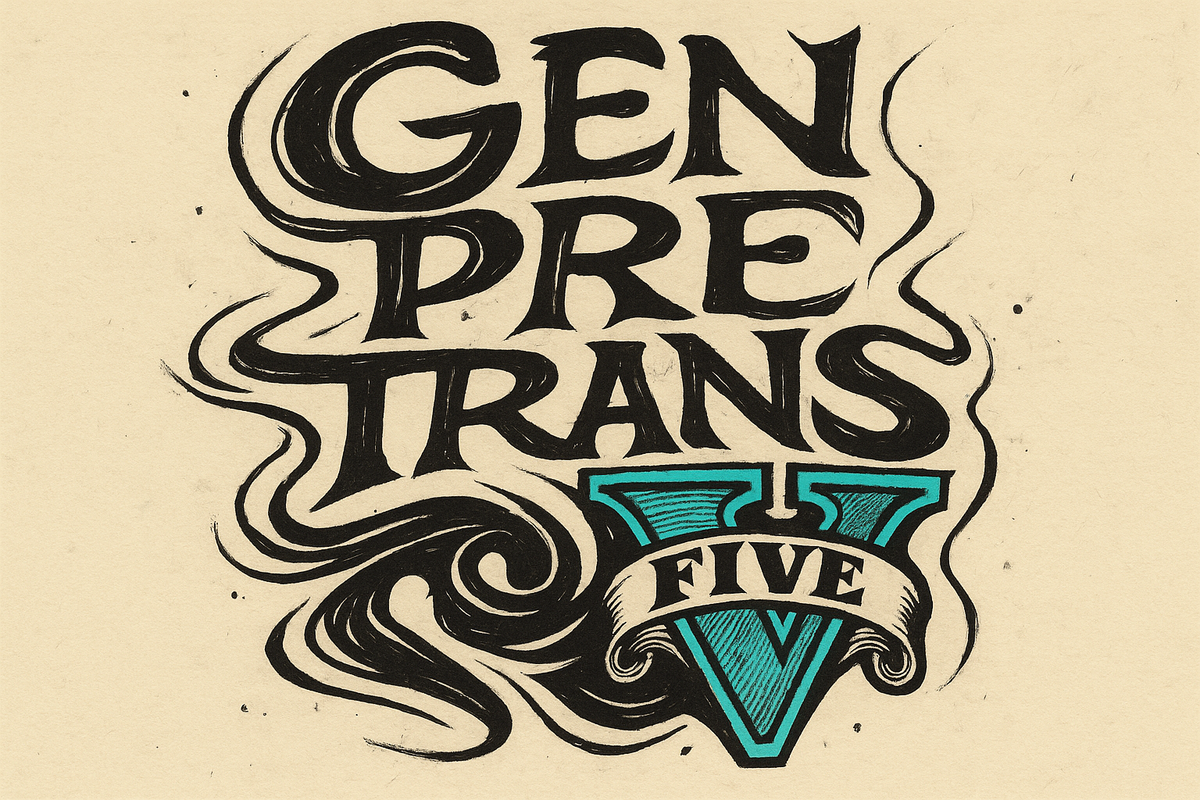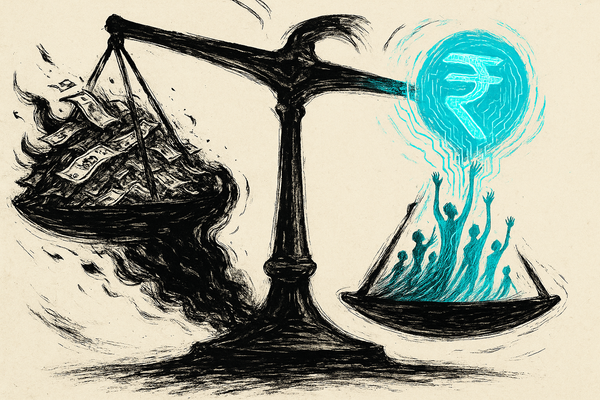ImaginEconomy Daily: GPT-5 Special Edition
GPT-5 launched yesterday, marking year zero for the imagination economy. With 74.9% coding accuracy, 45% fewer hallucinations, and 'vibe coding' that lets anyone build apps from descriptions, it's not just an upgrade—it's the end of business as we know it. The revolution costs $200/month.

The Day Everything Changed: OpenAI's GPT-5 Redefines Knowledge Work Forever
Yesterday at 10am PT, Sam Altman stepped onto a livestream and casually announced the end of the world as we know it.
Not with apocalyptic fanfare, but with a simple product launch that makes every previous AI advancement look like a warm-up act.
GPT-5 isn't just another model upgrade. It's the moment AI stops being a tool and starts being a colleague, with a PhD in everything, infinite patience, and no need for coffee breaks.
The Unified Intelligence: What GPT-5 Actually Is
GPT-5 is a unified system that knows when to respond quickly and when to think longer to provide expert-level responses. This isn't marketing fluff—it's a fundamental architectural shift. Unlike previous models that required choosing between speed (GPT-4o) or reasoning (o3), GPT-5 dynamically routes queries to the appropriate cognitive depth.
The numbers tell a story of dominance: 74.9% on SWE-bench Verified for real-world coding tasks, 88% on Aider polyglot for multilingual code editing, and perhaps most importantly, 45% fewer hallucinations than GPT-4o. With a 256,000-token context window, it can hold entire codebases, book manuscripts, or quarterly reports in its working memory.
But here's what's most meaningful: GPT-5 is available to all users, with Plus subscribers getting more usage, and Pro subscribers getting access to GPT-5 pro. Free users get a taste. Plus users at $20/month get comfortable daily use. Pro users at $200/month get unlimited access to what Altman calls "a team of Ph.D. level experts in your pocket." It's the ultimate free trial / gateway drug strategy.
ImaginEconomy Impact: The democratization is deceptive. Yes, everyone gets access, but the tiered structure creates a new class system in the knowledge economy. Those who can afford $200/month will operate at a fundamentally different cognitive level than those who can't. For agencies and consultancies, this isn't just a tool expense; it's the access ticket to relevance.
The Agentic Shift: From Answering to Acting
The most profound change isn't what GPT-5 knows but what it does and how it does it. GPT-5's improved tool intelligence lets it reliably chain together dozens of tool calls—both in sequence and in parallel—without losing its way, making it far better at executing complex, real-world tasks end to end.
Cursor says GPT-5 is "the smartest model [they've] used" and "remarkably intelligent, easy to steer, and even has a personality [they] haven't seen in other models." Windsurf shared GPT-5 is SOTA on their evals and "has half the tool calling error rate over other frontier models."
This isn't incremental improvement but categorical transformation. On τ2-bench telecom, a tool-calling benchmark released just 2 months ago, GPT-5 achieves SOTA results at 96.7%. In practical terms, this means GPT-5 can plan a project, allocate resources, write code, test it, deploy it, and document it, all the while you're in a meeting discussing the business impact and organizational implications of the end result.
ImaginEconomy Impact: Agencies built on traditional billable hours alone are dead companies walking. When an AI can execute complete workflows autonomously, the value proposition of human craft evaporates on many fields. The survivors will be those who shift from execution to vision, curation, orchestration and validation, becoming conductors of AI symphonies rather than individual musicians.
The "Vibe Coding" Revolution: Everyone's a Developer Now
OpenAI's post-training lead, Yann Dubois, said the model opens up "a whole new world of vibe coding," or the ability for noncoders to create fully deployable websites and apps just by describing what they want to build and letting an AI agent do the work.
Altman said he believes GPT-5's ability to "instantaneously create an entire piece of computer software for you" will likely be a core part of its appeal and use. "I think this idea of software on demand will be a defining part of the new GPT-5 era," he said.
When producing frontend code for web apps, GPT-5 is more aesthetically-minded, ambitious, and accurate. In side-by-side comparisons with o3, GPT-5 was preferred by testers 70% of the time.
This isn't just about making coding easier; it's about making coding irrelevant for a great number of digital product developers. When a marketing manager can describe a campaign microsite and have it built, tested, and deployed before lunch, the entire digital production industry faces existential questions.
ImaginEconomy Impact: Every creative brief becomes instantly executable code. Every strategy deck becomes a working prototype in a flash. The agencies that survive won't be those with the best developers, but those with the best taste. When everyone can build anything, the only differentiation is knowing what's worth it.
Microsoft's Full-Stack Domination Play
The speed of Microsoft's integration is breathtaking and a big part of their 4 trillion dollar price tag today. The upgrades will be available starting today, giving Microsoft's consumer, developer and enterprise users immediate access to the increased intelligence and advanced reasoning of the GPT-5 models.
With GPT-5, Microsoft 365 Copilot is better at reasoning through complex questions, staying on track in longer conversations and understanding the user's context. Customers with Microsoft 365 Copilot licenses can also reason over emails, documents and files, allowing enterprise users to apply OpenAI's most advanced models to stay on top of work responsibilities and be more productive.
Microsoft Copilot is the AI companion for everyday tasks, with the ability to assist users in getting answers to tough questions, sharpening their writing or turning ideas into images. Today, people can experience the power of GPT-5 in Copilot for free.
This is colonization at its most brutally effective. Microsoft has embedded GPT-5 into the entire productivity stack that runs the corporate world. Every email, every document, every line of code now has PhD-level intelligence hovering behind it.
ImaginEconomy Impact: The enterprise AI race is far from over, but Microsoft is undeniably in the lead. While competitors debate strategy, Microsoft is shipping crushingly capable AI to billions of users. For brands and agencies, the choice is binary: embrace the Microsoft-OpenAI axis at least partly, or accept potentially permanent disadvantage. The integration is deep, and resistance is futile.
The Creative Industry's Ground Zero Moment
86% of advertisers are already using AI for video creation, but GPT-5 is changing this equation too. Beyond faster production, GPT is promising complete commoditization of creative execution.
When GPT-5 can generate campaign concepts, write copy across all channels, produce visual assets through integrated tools, and even code the campaign websites, what exactly is an agency selling? The answer better not be implementation.
The numbers are brutal: production costs are fast approaching zero while client expectations for high-quality customization approach infinity. GPT-5 enables what was previously impossible: truly individual creative at mass scale. Not segments, not cohorts, but individuals.
ImaginEconomy Impact: The creative industry faces its Napster moment. Just as digital distribution destroyed the music industry's traditional business model overnight, GPT-5 destroys the agency model of endlessly marking up production. The new currency isn't creative output but compelling vision and creative judgment. Agencies transform from factories to filters, from makers to curators. Those clinging to the old model will discover that their clients and the world will move on quickly, with GPT-5 as their new creative department.
The Pricing Power Play: Democracy with a Price Tag
The tiered access model is genius in its simplicity and brutal in its implications:
- Free Tier: For ChatGPT free-tier users, full reasoning capabilities may take a few days to fully roll out. Once free users reach their GPT-5 usage limits, they will transition to GPT-5 mini, a smaller and faster but still capable model.
- Plus Tier ($20): Plus users can use it comfortably as their default model for everyday questions, with significantly higher usage than free users.
- Pro Tier ($200): Pro subscribers get unlimited access to GPT-5, and access to GPT-5 Pro for a 24/7 PhD level genie at their fingertips.
This creates a new caste system in the knowledge economy. The cognitive divide between those with unlimited GPT-5 access and those rationing queries on the free tier isn't just quantitative but qualitative. It's the difference between having an assistant and having a team.
ImaginEconomy Impact: The $200/month Pro subscription becomes the new MBA: a credential that signals serious professional intent. For agencies, this is a no-brainer expense that will be passed directly to clients. But for freelancers and small firms, it's a painful calculation: is superhuman intelligence worth 10 Netflix subscriptions? And can they afford to pay it?
The New SaaS: Singularity as a Service
GPT-5 isn't the singularity we were promised. But it's potentially something more insidious. Instead of AI achieving consciousness and leaving all of humanity behind, it's achieving immense competence and making some of us super-humans while leaving some of us behind.
Sam Altman and other luminaries have long promised that AI will benefit all humanity. But it's clear that with AGI as a service, the benefit will be proportional to payment. The revolution isn't equally distributed so much as it is methodically monetized.
For the ImaginEconomy—the brands, agencies, strategists, and creatives who trade in ideas and their execution—this is year zero. Everything before GPT-5 was practice. Everything after is performance.
The question isn't whether to adopt AI. That's like asking whether to adopt electricity or the internet. The question is whether you'll be the one wielding it with a master's skill or still practicing while the movie's main battle already rages on.
ImaginEconomy Daily Newsletter is curated for brand, business and marketing strategists, creatives, and leaders navigating the intersection of technology and human experience.




